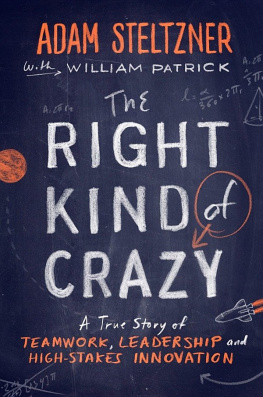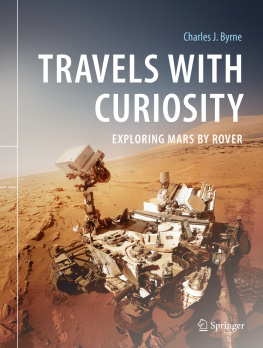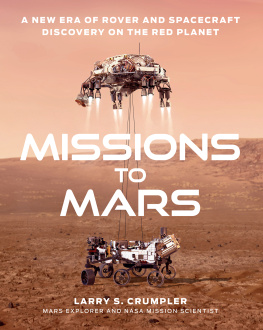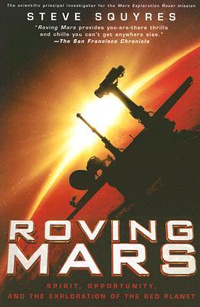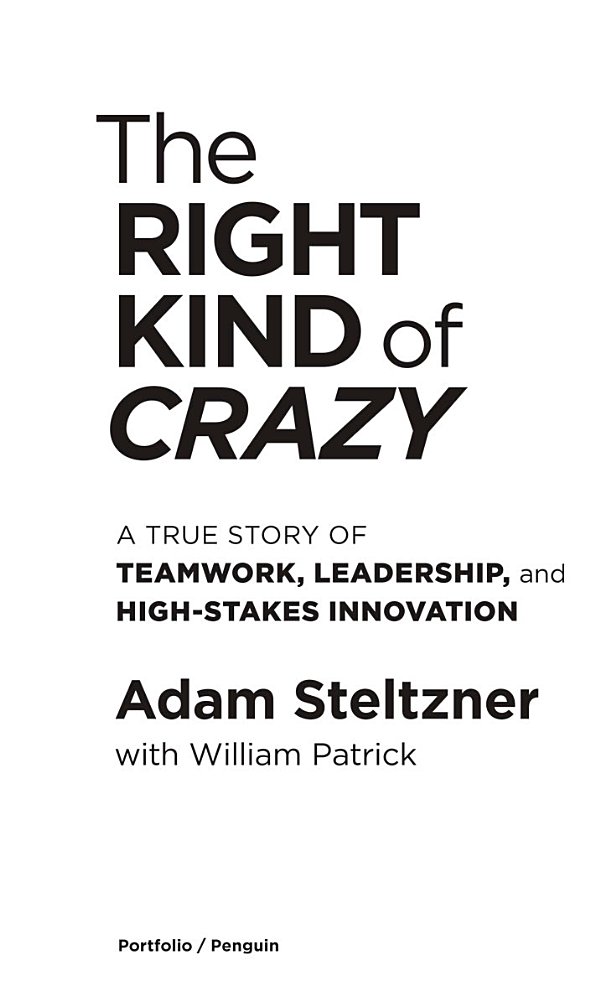Penguin supports copyright. Copyright fuels creativity, encourages diverse voices, promotes free speech, and creates a vibrant culture. Thank you for buying an authorized edition of this book and for complying with copyright laws by not reproducing, scanning, or distributing any part of it in any form without permission. You are supporting writers and allowing Penguin to continue to publish books for every reader.
Names: Steltzner, Adam, author.
Title: The right kind of crazy : a true story of teamwork, leadership, and high-stakes innovation / Adam Steltzner, with William Patrick.
Description: New York : Portfolio, 2016.
Subjects: LCSH: Steltzner, Adam. | Curiosity (Spacecraft) | Jet Propulsion Laboratory (U.S.) | Aerospace engineersUnited States. | Roving vehicles (Astronautics) | Space vechiclesLandingMars (Planet) | Mars (Planet)Exploration. | BISAC: BUSINESS & ECONOMICS / Leadership. | BUSINESS & ECONOMICS / Organizational Behavior. | TECHNOLOGY & ENGINEERING / Aeronautics & Astronautics.
I wish to dedicate this book to Dr. Stephen Prata, my first physics instructor at College of Marin, in Kentfield, California. Dr. Prata shared with his class the thrill and glee he found in the act of discovery. He showed his students that there was a grand, big world out there for us to understand if we followed our curiosity. Curiosity is a spark, and thinking, exploration, and learning are the fires that burn from it. Dr. Prata helped me find that spark of curiosity that led to a fire of exploration and learning that changed my life, burned across the span of time, and put me where I am today, writing of this fantastic journey.
Chapter 1
SINATRA, AND A LOT OF BRASS
Im at the Jet Propulsion Laboratory in Pasadena, California, in the Cruise Mission Support Area, mission control, hooking up my iPhone to the Voice Operational Communications Assembly (VOCA), getting ready to launch Ol Blue Eyes singing Nelson Riddles 1966 arrangement of All or Nothing at All.
Its just before 8 p.m. on August 5, 2012, and were nearing the climax of a massive team effort to land a rover the size of a MINI Cooper on Mars. The overall project, called Mars Science Laboratory, has taken ten years to reach this point. Before were done tonight, well have set that rover down gently at our selected site, or well have made a smoking crater on the surface of Mars. Whichever way it goes, we wont even know for seven minutes. Thats how long it takes data from Mars to reach us back on Earth.
Hunched over the desktop beside me, jamming his VOCA headset into the small iPhone speakers, is my good friend Miguel San Martin, who is also my deputy in managing our part of the project: the critical component known as Entry, Descent, and Landing (EDL).
The assignment we took on nearly a decade ago sounded straightforward enough: Design a way to deliver a 5,359-pound entry vehicle, which carries a 1,982-pound rover called Curiosity, into the Martian atmosphere without harm, then slow it down, guide it to the landing site, and put it down on the surface, safe and sound.
In just a couple of hours10:32 p.m. Pacific timewell know how well we did. Its our all-or-nothing moment, the moment of truth.
As the engineer leading the EDL team, my main job tonight is to be on hand to accept praise or scorn on behalf of the team. Ours is perhaps the most treacherous part of this incredibly complex mission, and definitely the most visible. Like a flaming guitar solo in a stadium concert, EDL might not be the missions most fundamental element but it is the part that everyone will remember, good or bad, the next day.
Thousands of people have spent a big hunk of their professional lives working fifty- to eighty-hour weeks on this mission; I have fifty colleagues in EDL alone. This is a complete team effort, and an effort of a truly remarkable team at that. But as my friend, mentor, and senior sage at the Jet Propulsion Laboratory (JPL), Gentry Lee, says, there has to be one ass to kick, and that ass is mine.
At JPL theres a long tradition of playing a wake up song at the start of every new day on Mars. Most of the choices have been bright and chipper, like Dont Worry, Be Happy. But Mig and I are in charge tonight, and the musics our call. As is our custom, weve tried to make a selection that speaks the truth of the situation were in.
We flip the switch, and our little broadcast goes out through JPLs VOCA system to headsets all over the world. First comes some smooth and mellow brasstrombones, I guessthen a tease of muted trumpets, then more trombones, then another tease from the Hammond B-3, all riding atop that swinging drumbeat. And then the Voice with the Message: All... or nothing at all...
I take a moment to relish the sound, which is totally cinematic. You can see the helicopter shot over Mulholland Drive at sunset with the LA skyline below. Or maybe a 57 T-bird pulling into the Sands in Vegas with Deano at the wheel and Sammy Davis Jr. riding shotgun. Its a skinny-tie, dry-martini arrangement, perfect for a caper like Oceans Eleventhe original, not the remake.
Listening alongside us in mission control are brass of another kind. The president of the California Institute of Technology is in the room, as is the head of JPL (which is an arm of Caltech), along with the head of NASA. Even the film director James Cameron is on hand to see what a real Mars landing looks like.
Since the space shuttle program was canceled in 2010, Mars has been the only game in town for NASA brass, and for space geeks this landing is the World Cup. A couple of large rooms manned by caterers and equipped with large fishbowl windows looking into the control room are filled with an assortment of governors and congressmen and other people wearing suits with flag lapel pins. At one point it looked as if the First Lady would attend, but something must have come up.
Our mission managers selected this date for the landing more than a year ago, based on celestial mechanics and the position of existing Mars orbiters that could photograph our descent and otherwise relay data. The rendezvous was set in motion last November, when the capsule carrying Curiosity was launched from the Kennedy Space Center aboard a $300 million Atlas V-51 rocket. This means that our spacecraftthe product of almost a decade of many of our lives and the result of more than ten thousand human years of efforthas been hurtling through interplanetary space toward the Red Planet at about 13,000 miles an hour for the past eight and a half months.
Getting a payload to Mars is hard. The target is anywhere from 40 million to 350 million miles away, depending on the alignment of the planets, and its orbiting the sun at 24 kilometers a second, more than 50,000 miles per hour. Landing a rover full of delicate scientific instruments at a specific sitein this case the Gale Crater, near Mount Sharp, in the northwestern corner of the Aeolis quadrangleand at precisely the right moment is harder still. Yet this was the objective of the team of engineers I had the privilege to lead.
The idiosyncrasies of Marss dust-laden carbon dioxide atmosphere dont make the job any easier. The planet has one-third the gravity of Earth. Its atmosphere is so thin that the air offers little resistance to an object hurtling through itbut is still thick enough to cause tremendous heating when you show up going 13,000-some-odd miles an hour. Youll need to come equipped with both an outsize parachute to slow you downone that can open while youre still going nearly twice the speed of soundand a heat shield to keep you from bursting into flames as you enter.

